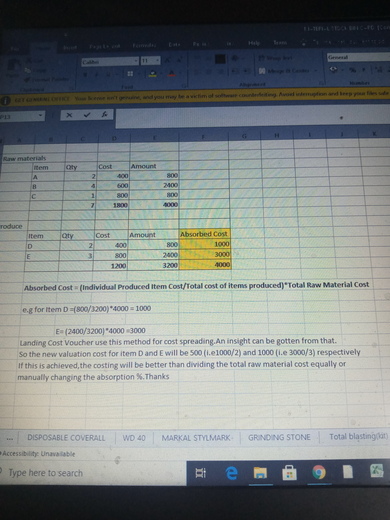This is an interesting and unique solution. Thank you.
Good idea
But where will the cost come from if the item is been manufactured for the first time ?
From the product (Item) set up. The Standard Buying Price.
For an item you manufacture??
By definition when you manufacture it you usually do not buy it.
And buying price is not same as cost.
You know the Buying Cost is the first valuation of an item.As you select the item to produce, if the Buying Cost is set up,by default that cost is pulled by the system as the cost of the item.
Hi Fred,
I get my clients to use Stock Entry Purpose Manufacture (think ver 12 and prior). In that entry I ensure that the Valuation of the Transformed (manufactured) item is not set in the item master. So ERPNext loads up the valuation of the input items to the valuation of the manufactured item and so long as the Expense account for the Input items and the transformed items are the same, there is no effect on the accounting books. Just that the stock balance value of the warehouse where the raw material is consumed goes down and the stock balance value of the warehouse where the transformed (manufactured) item is dropped goes up.
Or am I missing something?
Thanks
Jay
I mean make another DocType and add two child tables. One for items, UOMs and Quantities consumed and another for Items UOMs and Quantities Transformed. In the Transformed Items table add a field % Valuation and the Number here needs to add up to 100 for all items. Use a Make button and let this feed into Stock Entry Purpose Repack. Or Stock Entry Purpose: Manufacture and let the script feed in the valuation rates of the transformed items based on the %age set in the new DocType and the valuation of the input items.
Hope this helps.
Thanks
Jay
That means it is similar to what @olamide_shodunke showed us above which we have adjudged to be very good and that will solve a lot of problems in manufacturing. An for better costing he has agreed that using weighted averaged cost of product produced is good.But has pointed out a problem of getting the initial cost of the first production.
We don’t know whether your suggested solution of making the expense account for both the raw materials and the finished goods will work in his app.
Apologies for the delay in responding
https://github.com/CloudERPng/simplified-production-master
Let me know what you think
@olamide_shodunke Thanks for this solution.I have installed and tested it and worked as intended.However the cost apportionment is based on the quantity per each items produced.This is excellent if one item is produced.But where more than one items are produced,costing based only on quantity of item produced will certainly not work well in real life situation.Take for example a production process that resulted in producing 20 pieces of 1.5kgLoaves and 30 pieces of 0.7kgLoaves.The cost allocation will automatically be 40% of raw material cost to 1.5kgLoaves and 60% of raw material cost to 0.8kgLoaves.If this is allowed you will discover that the profitability analysis of the two items will be distorted.However if we want to manually allocate the % of cost absorption,it will merely be a guess work.The best way to do is to see how to use weighted average cost and quantity of the items produced.Strongly believe the barrier of initial cost of the produced items as opined above can be overcome.
@szufisher may want to chime in.
Once again,thanks for this wonderful innovation.
The item’s amount field for the manufactured product may be considered as percentage-weight for costing purposes. Then, this can be used even for process manufacturing where one (or more) raw material items produces multiple types of processed finished products.
Just for the record, we have 470K active BOMs. Managing them is tough, but it is still the best method.
Holy Moly!!!
